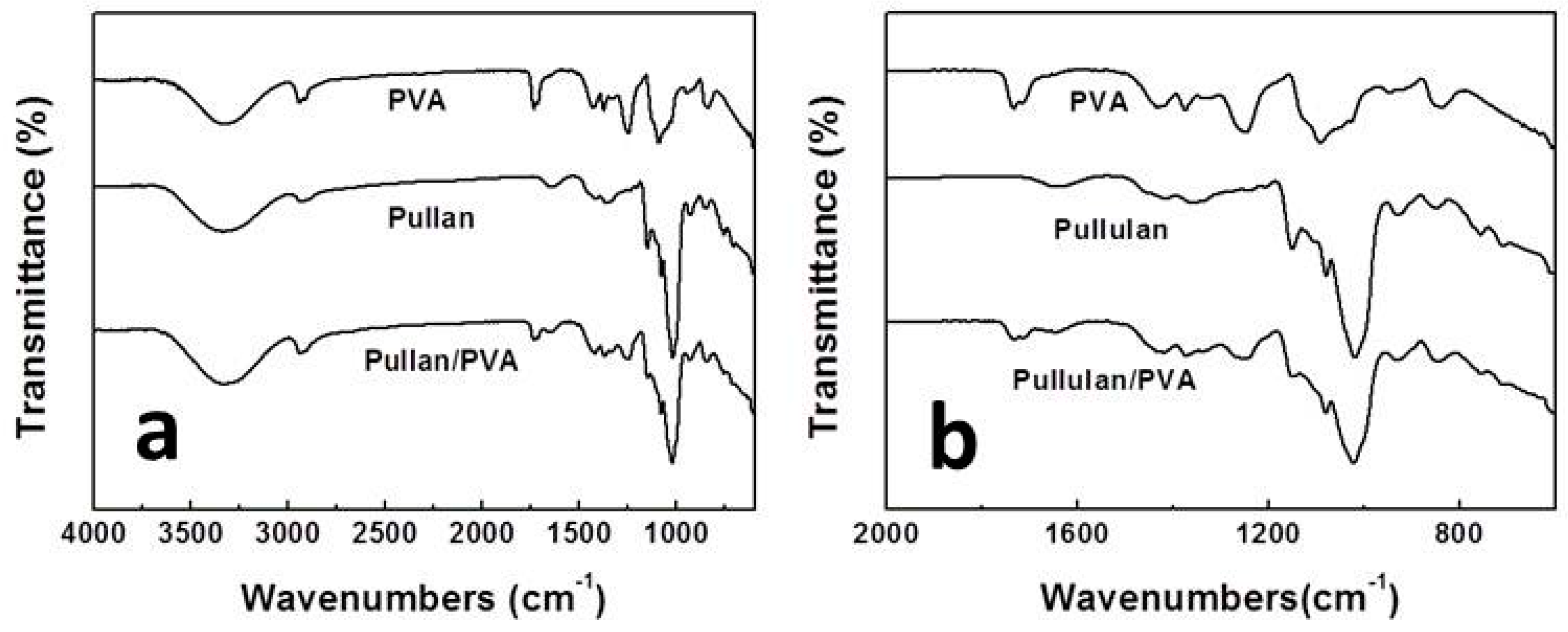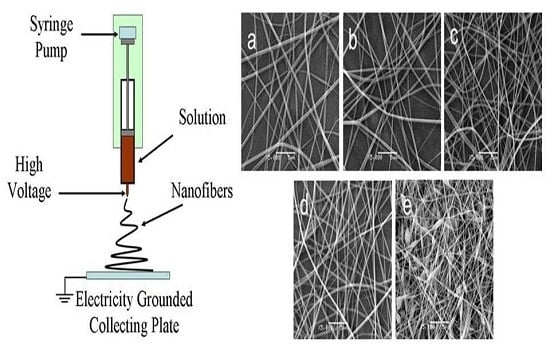Incorporation of Rutin in Electrospun Pullulan/PVA Nanofibers for Novel UV-Resistant Properties
Abstract
:1. Introduction
2. Results and Discussion
2.1. Morphology of Electrospun Pullulan and PVA Nanofibers
2.2. The Effect of Rutin on Electrospun Pullulan and PVA Nanofibers
2.3. FTIR Analysis of Electrospun Pullulan/PVA and Pullulan/PVA/Rutin Nanofibers
2.4. Mechanical Properties of PVA/Pullulan and PVA/Pullulan/Rutin Nanofibrous Mats
2.5. The Ultraviolet-Resistant Property of the Electrospun Nanofibrous Mats Containing Rutin
3. Materials and Methods
3.1. Materials
3.2. Preparation of the Spinning Solution and Electrospinning
3.3. Characterization of the Membranes
4. Conclusions
Acknowledgments
Author Contributions
Conflicts of Interest
References
- Park, K.E.; Jung, S.Y.; Lee, S.J.; Min, B.; Park, W.H. Biomimetic nanofibrous scaffolds: Preparation and characterization of chitin/silk fibroin blend nanofibers. Int. J. Biol. Macromol. 2006, 38, 165–173. [Google Scholar] [CrossRef] [PubMed]
- Jiang, S.; Liu, F.; Lerch, A.; Ionov, L.; Agarwal, S. Unusual and superfast temperature-triggered actuators. Adv. Mater. 2015, 27, 4865–4870. [Google Scholar] [CrossRef] [PubMed]
- Schiffman, J.D.; Schauer, C.L. A review: Electrospinning of biopolymer nanofibers and their applications. Polym. Rev. 2008, 48, 317–352. [Google Scholar] [CrossRef]
- Greiner, A.; Wendorff, J.H. Electrospinning: A fascinating method for the preparation of ultrathin fibres. Angew. Chem. Int. Ed. 2007, 46, 5670–5703. [Google Scholar] [CrossRef] [PubMed]
- Kachhawa, D.K.; Bhattacharjee, P.; Singhal, R.S. Studies on downstream processing of pullulan. Carbohydr. Polym. 2003, 52, 25–28. [Google Scholar] [CrossRef]
- Singh, R.S.; Saini, G.K.; Kennedy, J.F. Pullulan: Microbial sources, production and application. Carbohydr. Polym. 2008, 73, 515–531. [Google Scholar] [CrossRef] [PubMed]
- Leathers, T.D. Biotechnological production and applications of pullulan. Appl. Microbiol. Biotechnol. 2003, 62, 468–473. [Google Scholar] [CrossRef] [PubMed]
- Islam, M.S.; Yeum, J.H.; Das, A.K. Effect of pullulan/poly(vinyl alcohol) blend system on the montmorillonite structure with property characterization of electrospun pullulan/poly(vinyl alcohol)/montmorillonite nanofibers. J. Colloid Interface Sci. 2012, 368, 273–281. [Google Scholar] [CrossRef] [PubMed]
- Karim, M.R.; Lee, H.W.; Kim, R.; Ji, B.C.; Cho, J.W.; Son, T.W.; Oh, W.; Yeu, J.H. Preparation and characterization of electrospun pullulan/montmorillonite nanofiber mats in aqueous solution. Carbohydr. Polym. 2009, 78, 336–342. [Google Scholar] [CrossRef]
- Islam, M.S.; Akter, N.; Karim, M.R. Preparation of superhydrophobic membranes by electrospinning of fluorinated silane functionalized pullulan. Colloids Surf. A 2010, 362, 117–120. [Google Scholar] [CrossRef]
- Karim, M.R.; Islam, M.S. Thermal Behavior with Mechanical Property of Fluorinated Silane Functionalized Superhydrophobic Pullulan/Poly(vinyl alcohol) Blends by Electrospinning Method. J. Nanomater. 2011, 2011, 979458. [Google Scholar] [CrossRef]
- Lee, H.W.; Karim, M.R.; Ji, H.M.; Choi, J.H.; Ghim, H.D.; Park, S.M.; Oh, W.; Yeum, J.H. Electrospinning fabrication and characterization of Poly(vinyl alcohol)/montmorillonite nanofiber mats. J. Appl. Polym. Sci. 2009, 113, 1860–1867. [Google Scholar] [CrossRef]
- Mahmoodi, N.M.; Moktari-Shourijeh, Z. Preparation of PVA-chitosan blend nanofiber and its dye removal ability from colored wastewater. Fibers Polym. 2015, 6, 1861–1869. [Google Scholar] [CrossRef]
- Sousa, A.M.M.; Souza, H.K.S.; Uknalis, J.; Liu, S.C.; Goncalves, M.P.; Liu, L.S. Electrospinning of agar/PVA aqueous solutions and its relation with rheological properties. Carbohydr. Polym. 2015, 115, 348–355. [Google Scholar] [CrossRef] [PubMed]
- Wang, P.; He, J.H. Electrospun polyvinyl alcohol-milk nanofibers. Therm. Sci. 2013, 17, 1515–1516. [Google Scholar] [CrossRef]
- Wang, P.; He, J.H. Electrospun polyvinyl alcohol-honey nanofibers. Therm. Sci. 2013, 17, 1549–1550. [Google Scholar] [CrossRef]
- Wang, X.; Yue, T.; Lee, T. Development of Pleurocidin-poly(vinyl alcohol) electrospun antimicrobial nanofibers to retain antimicrobial activity in food system application. Food Control 2015, 54, 150–157. [Google Scholar] [CrossRef]
- Arima, H.; Ashida, H.; Danno, G. Rutin-enhanced Antibacterial Activities of Flavonoids against Bacillus cereus and Salmonella enteritidis. Biosci. Biotechnol. Biochem. 2002, 66, 1009–1014. [Google Scholar] [CrossRef] [PubMed]
- Roy, S.; Majumdar, S.; Singh, A.K.; Ghosh, B.; Ghosh, N.; Manna, S.; Chakraborty, T.; Mallick, S. Synthesis, characterization, antioxidant status, and toxicity study of vanadium–rutin complex in Balb/c Mice. Biol. Trace Elem. Res. 2015, 166, 183–200. [Google Scholar] [CrossRef] [PubMed]
- Kostyuk, V.A.; Potapovich, A.I.; Lulli, D.; Stancato, A.; de Luca, C.; Pastore, S.; Korkina, L. Modulation of human keratinocyte responses to solar UV by plant polyphenol as a basis for chemoprevention of non-melanoma skin cancers. Curr. Med. Chem. 2013, 20, 869–879. [Google Scholar] [CrossRef] [PubMed]
- Suzuki, T.; Morishita, T.; Kim, S.J.; Park, S.U.; Woo, S.H.; Noda, T.; Takigawa, S. Physiological roles of rutin in the buckwheat plant. Jpn. Agric. Res. Q. 2015, 49, 37–43. [Google Scholar] [CrossRef]
- Xing, Z.C.; Koo, T.H.; Kim, Y.J.; Kwon, O.H.; Kang, I.K. Surface modification of PLGA nanofibrous biocomposites using flavonoids for biomedical applications. J. Adhes. Sci. Technol. 2013, 27, 1382–1392. [Google Scholar] [CrossRef]
- Zong, X.; Kim, K.; Fang, D.; Ran, S.; Hsiao, B.S.; Chu, B. Structure and process relationship of electrospun bioabsorbable nanofiber membranes. Polymer 2002, 43, 4403–4412. [Google Scholar] [CrossRef]
- Xu, J.; Zhang, J.; Gao, W.; Liang, H.; Wang, H.; Li, J. Preparation of chitosan/PVA blend micro/nanofibers by electrospinning. Mater. Lett. 2009, 63, 658–660. [Google Scholar] [CrossRef]
- Zhang, K.; Wang, H.; Huang, C.; Su, Y.; Mo, X.; Ikada, Y. Fabrication of silk fibroin blended P(LLA-CL) nanofibrous scaffolds for tissue engineering. J. Biomed. Mater. Res. A 2010, 93, 984–993. [Google Scholar] [CrossRef] [PubMed]
- Calabro, M.L.; Tommasini, S.; Donato, P.; Stancanelli, R.; Raneri, D.; Catania, S.; Costa, C.; Villari, V.; Ficarra, P.; Ficarra, R. The rutin/β-cyclodextrin interactions in fully aqueous solution: Spectroscopic studies and biological assays. J. Pharm. Biomed. Anal. 2005, 36, 1019–1027. [Google Scholar] [CrossRef] [PubMed]
- Liu, X.; Song, R.; Yu, W.; Pan, N. Developing UV-protective cotton fabric based on SiOx nanoparticles. Fibers Polym. 2012, 13, 489–494. [Google Scholar] [CrossRef]





| Pullulan/PVA | 100/0 | 75/25 | 50/50 | 25/75 |
|---|---|---|---|---|
| Stress (MPa) | 1.07 ± 0.062 | 1.72 ± 0.125 | 1.94 ± 0.09 | 2.56 ± 0.147 |
| Strain (%) | 31 ± 3.606 | 28 ± 4.583 | 25 ± 5.568 | 19 ± 2.646 |
| Rutin (%) | 0 | 3.23 | 4.46 | 5.67 | 7.41 |
|---|---|---|---|---|---|
| Stress (MPa) | 1.94 ± 0.09 | 2.38 ± 0.274 | 2.85 ± 0.298 | 3.22 ± 0.368 | 3.1 ± 0.171 |
| Strain (%) | 25 ± 5.568 | 23 ± 2 | 21 ± 2.646 | 16 ± 2.646 | 12 ± 3 |
| Rutin (%) | 0 | 3.23 | 4.46 | 5.67 | 7.41 | 8.54 |
|---|---|---|---|---|---|---|
| T(UVA) (%) | 6.06 ± 0.68 | 3.34 ± 0.36 | 2.44 ± 0.8 | 2.24 ± 0.07 | 0.76 ± 0.15 | 0.53 ± 0.17 |
| T(UVB) (%) | 5.29 ± 0.69 | 2.75 ± 0.36 | 1.8 ± 0.82 | 2.25 ± 0.07 | 0.9 ± 0.10 | 0.61 ± 0.23 |
| UPF | 23 ± 2.75 | 29 ± 2.45 | >40 | >50 | >50 | >50 |
© 2016 by the authors; licensee MDPI, Basel, Switzerland. This article is an open access article distributed under the terms and conditions of the Creative Commons Attribution (CC-BY) license (http://creativecommons.org/licenses/by/4.0/).
Share and Cite
Qian, Y.; Qi, M.; Zheng, L.; King, M.W.; Lv, L.; Ye, F. Incorporation of Rutin in Electrospun Pullulan/PVA Nanofibers for Novel UV-Resistant Properties. Materials 2016, 9, 504. https://doi.org/10.3390/ma9070504
Qian Y, Qi M, Zheng L, King MW, Lv L, Ye F. Incorporation of Rutin in Electrospun Pullulan/PVA Nanofibers for Novel UV-Resistant Properties. Materials. 2016; 9(7):504. https://doi.org/10.3390/ma9070504
Chicago/Turabian StyleQian, Yongfang, Mengjie Qi, Laijiu Zheng, Martin W. King, Lihua Lv, and Fang Ye. 2016. "Incorporation of Rutin in Electrospun Pullulan/PVA Nanofibers for Novel UV-Resistant Properties" Materials 9, no. 7: 504. https://doi.org/10.3390/ma9070504






